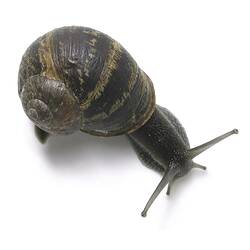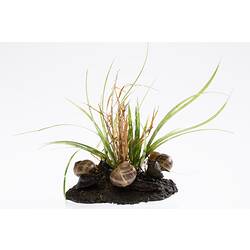General Description
Body grey-brown. Shell brown with dark brown or black lines and yellow streaks, circular with 4-5 whorls. Shell up to 4 cm across.
Biology
Garden Snails are hermaphrodites but reproduce sexually. They lay clutches of up to 80 eggs at a time and may lay up to six clutches a year under favourable conditions. Garden Snails were introduced into Tasmania to provide food for birds, such as the European thrush and blackbird. They feed on a wide variety of plants, including fruit trees and vegetable crops as well as garden flowers and are considered major pests by many gardeners. Some are caught for the restaurant escargot trade.
Distribution
Europe, Africa, North and South America, New Zealand. Eastern mainland Australia and Tasmania.
Habitat
Among groundcover plants in damp areas.
More Information
-
Animal Type
-
Animal SubType
-
Brief Id
Round shell with spiral, soft body.
-
Colours
Brown, Grey
-
Maximum Size
4 cm
-
Habitats
Wetland, Urban, DryForest, WetForest, Woodland, Mallee, Grassland
-
Diet
Herbivore
-
Endemicity
-
Commercial
Yes
-
Conservation Statuses
CITES: Not listed, FFG Threatened List: Not listed, EPBC Act 1999: Not listed, IUCN Red List: Not listed
-
Taxon Name
-
Scientific Author
(Müller, 1774)
-
Common Name
Common Garden Snail
-
Phylum
-
Subphylum
-
Class
-
Subclass
-
Order
-
Suborder
-
Infraorder
-
Superfamily
-
Family
-
Genus
-
Species Name
aspersa




